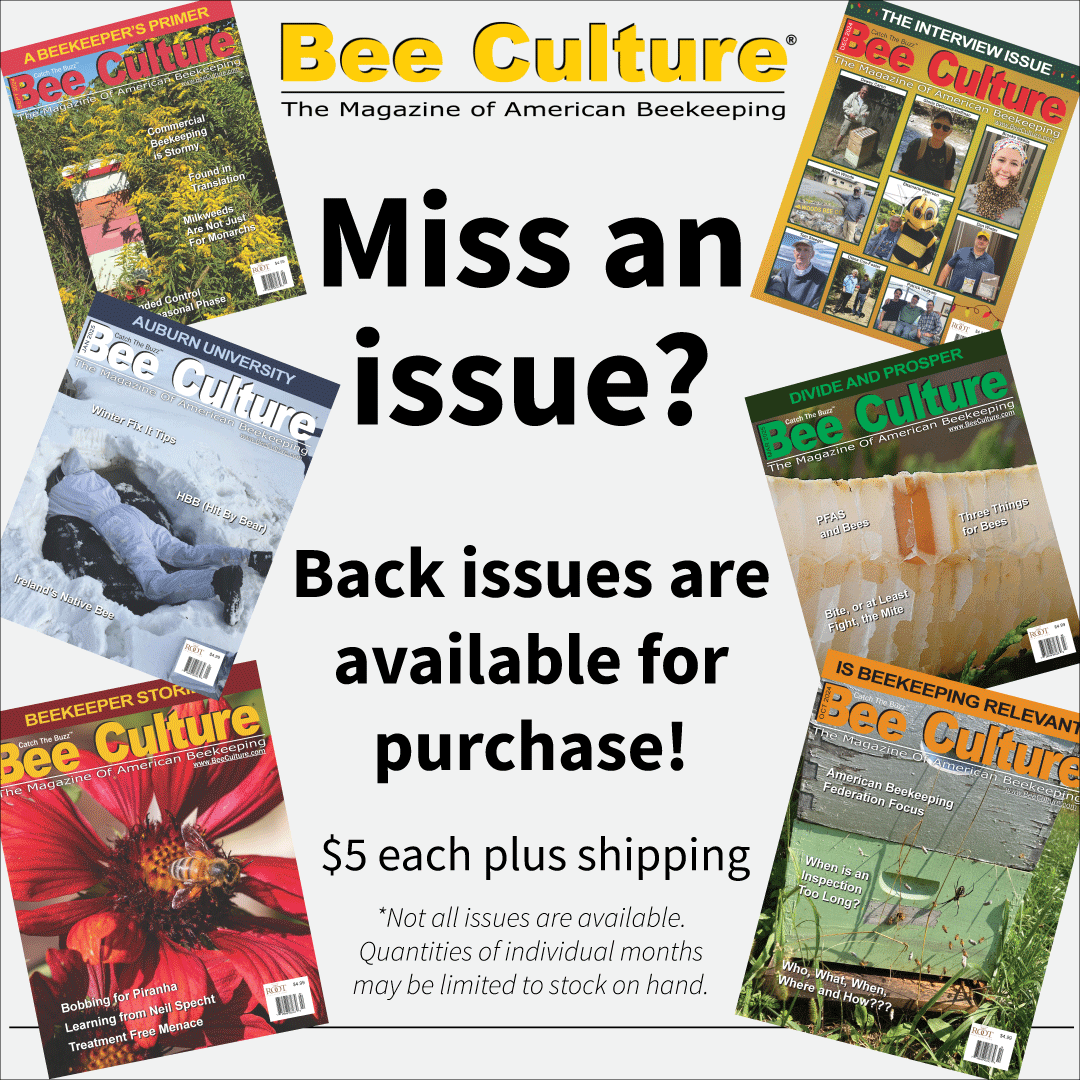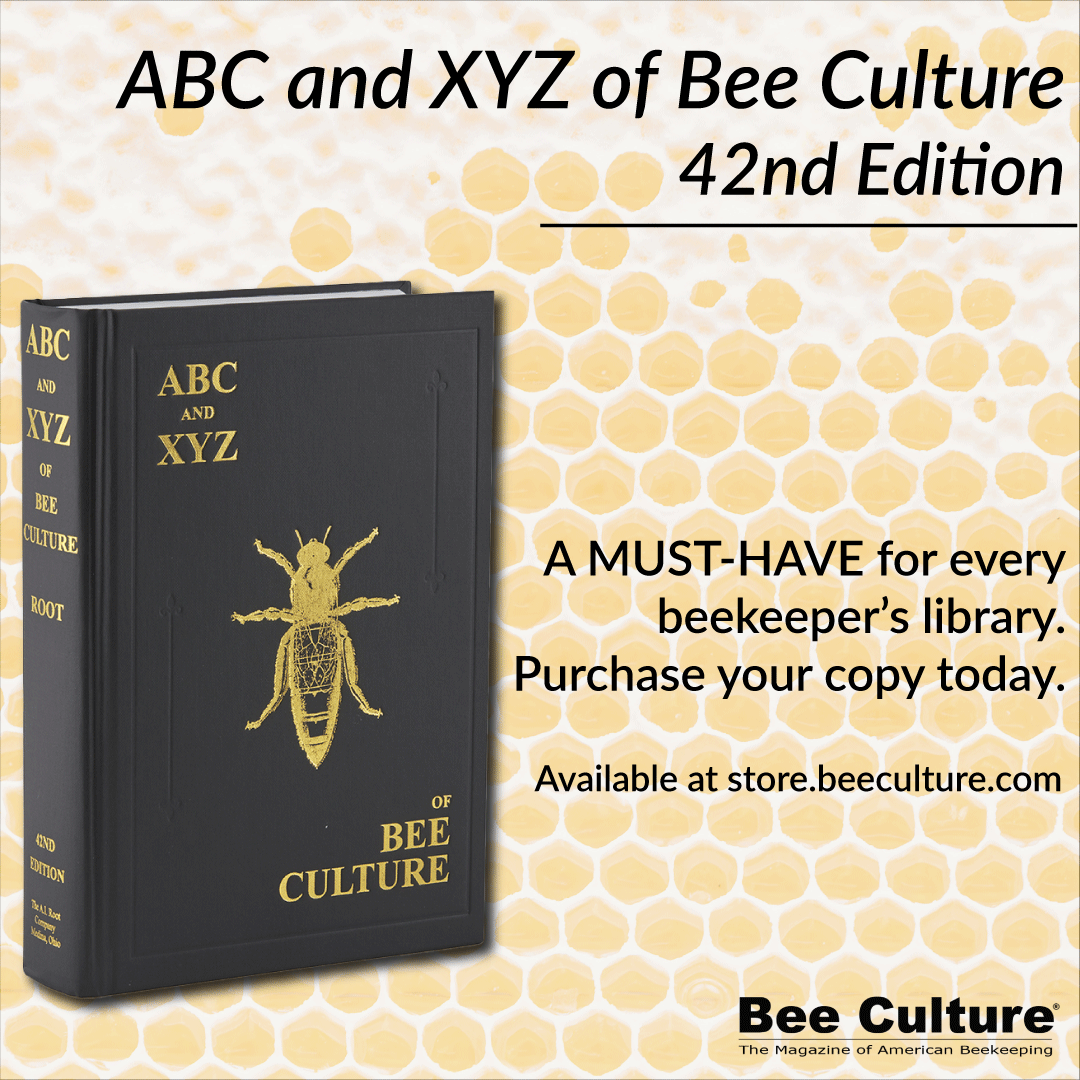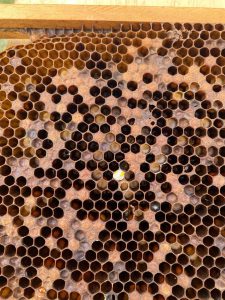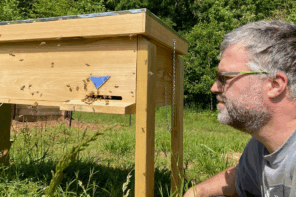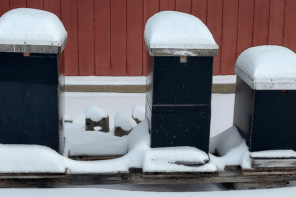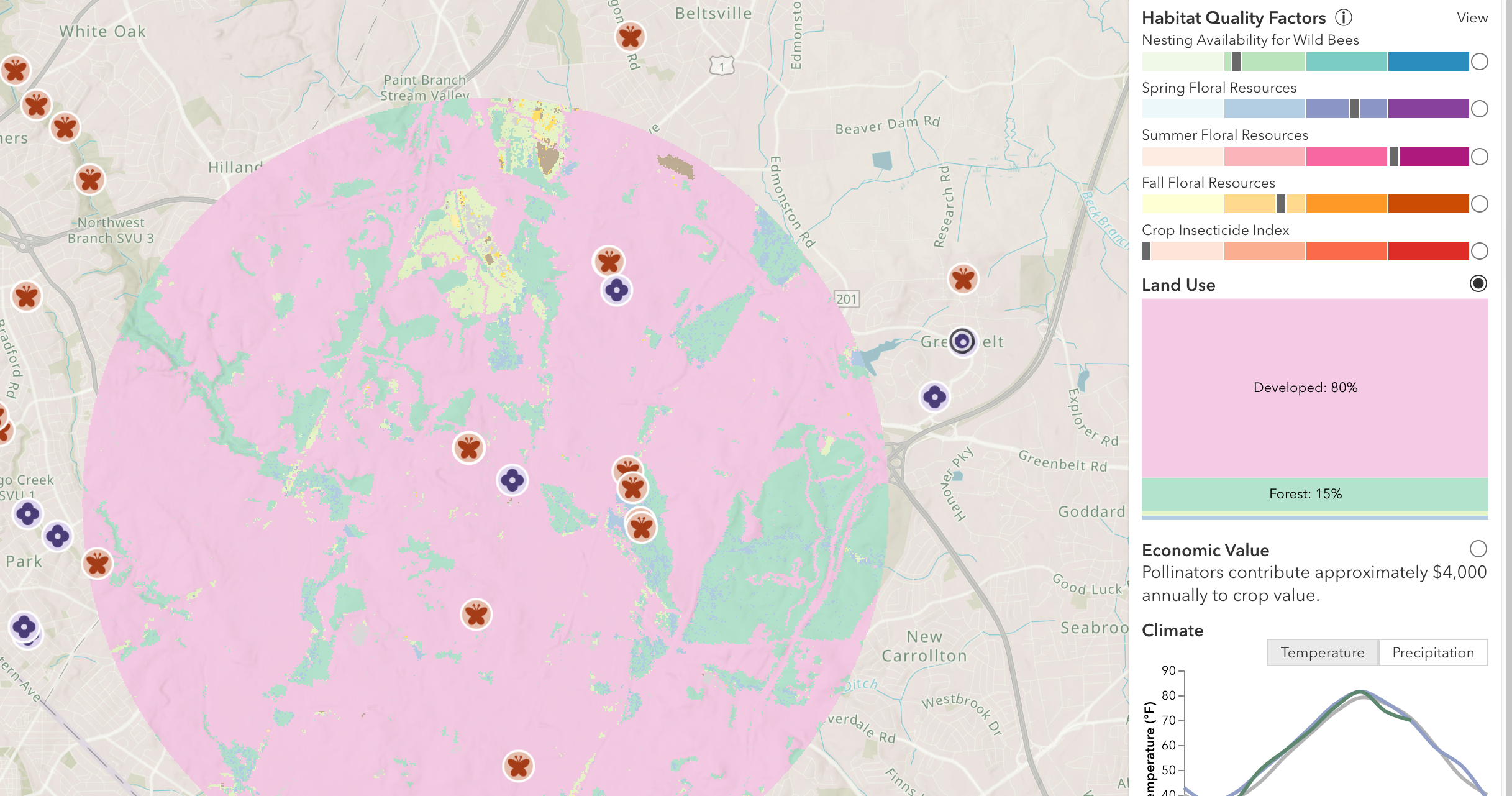A Hobbyist’s Epxerience
Charlotte Hubbard & Robert Candido
Opening a hive and deeply breathing in the scent, seeing those shiny, curious faces staring back, and (most of the time) watching bees do their thing without too much concern about the beekeeper; don’t we all love the simple joys of beekeeping? That magic of communing with another species will often push aside troubles and bring about a special sort of meditation.
Of course, not every visit is all sunshine and plump pearly larvae. Sometimes there are small hive beetles (satisfyingly squishable) and queen issues (solvable over time). Sparingly, across the season, chalkbrood or European Foulbrood (sigh) may appear. Never American Foulbrood (AFB) though. That’s something that only happens to others far away, right?
Wrong. Oh, the endless learning curve of beekeeping. While routinely checking hives in July, my buddy Robert found what sounded possibly like AFB, presenting as spotty, discolored brood and disconcerted bees—but no detectable off-putting or remarkable odor. Knowing something was amiss, Robert field-tested for AFB (piercing a capped pupa with a small stick to see if it pulled out ropy and long). It did not. He texted me brood photos, seeking insight.
The photos definitely depicted an ugly brood situation. I was out of town and referred Robert to another local beekeeper, Todd Smith, who hopped in his big white truck (not a white horse, but similar). Todd helped Robert accurately test for AFB. Robert had been piercing healthy capped brood, not those that were sunken, so he had not seen the telltale ropiness. Todd made sure to pierce and test sunken, diseased looking cappings, which revealed AFB’s characteristic ropiness.
I can’t say I was sorry to be out of town. My AFB experience thankfully has been limited to reading and lectures, but I’ve heard the horror stories of beekeepers burning entire apiaries. Robert’s tribulations made me immediately fearful. Learning that conscientious beekeeper Robert–who has always focused on disease prevention and safety–had found AFB in his operations, well, it steals some of my beekeeping joy. The one degree of separation of Robert’s experience now gives me pause every time I crack open a hive. There is the possibility that I’ll be in similar beekeeping boots someday, or someone else I know will.
But as I learned through Robert’s situation, AFB is manageable with quick and extensive action. He and I teamed up to further share this experience, in hopes that it will help others.
Addressing AFB
In Robert’s apiary, the infected pupae roped out more than 2 cm, and AFB was confirmed by Todd with the Holst Milk Test. After discussions of possible remediations, they elected to apply the shook swarm method1 – involving lots of work and new equipment. This effort was combined with antibiotics, requiring a Veterinary Feed Directive (Robert worked with a local veterinarian introduced to him by Todd), and lots of ongoing aftercare, including:
- Implementing strict bio-security protocols in the effected apiary. No equipment from the apiary has been transferred elsewhere. The effected frames, hive bodies, bottom and top boards were all burned and buried.
- Robert also follows extensive sanitary procedures throughout his operations, (as should we all). As examples: All hive tools are scrubbed with Bar Keepers Friend to remove all remnants of propolis and then fully heated with a propane torch. Robert wears nitrile gloves, changed between each hive in the apiary. High touchpoints on toolboxes and smokers have been covered with duct tape so he can use isopropyl alcohol to remove residues from his equipment. After each use, tools go into a bucket to be cleaned and sanitized. Only clean tools and equipment are carried in his beekeeping toolbox. No honey was collected from this apiary this year; it’s unsafe for humans because of the antibiotic use and unsafe to be fed to other bees because it may contain AFB spores. Jackets and veils are now regularly laundered with chlorine bleach.
Days after discovering the first AFB incidence, Robert visited his second apiary. Immediately upon opening a hive, he smelled AFB, noting, “I can identify foulbrood without difficulty now. I found suspect brood and checked them with a stick; they strung out. I confirmed with a commercially available AFB test kit. It returned positive, almost immediately.”
Robert didn’t have the time or equipment for another shake remediation. He dug a large pit, asked his wife on an unusual date, grabbed some lawn chairs, and later that evening, began burning. A documentary from New Zealand2 recommended euthanizing using gasoline, which Robert felt was very effective and minimized suffering, noting “about a pint of gasoline took down a 3-deep hive with a super in an instant.” The burn took about four hours.
This approach was also a lot of work, but Robert felt it to be less stressful than the shake method and all the aftercare it requires. “I wanted to save the bees given all the resources one needs,” he continued. “but I didn’t have those this second time, and honestly…burning the hive is the best way. Handling AFB in that yard is now done [it was an apiary of just one hive] and I can now give full attention to my other hives.”
The aftercare of the shook swarm method, Robert reports, is very involved. Installed on all-new equipment, the colony was fed constantly to help them draw comb and dosed with the prescribed medication. To spot AFB as early as possible, he has been making weekly full inspections looking for suspect larvae not just in that colony, but in all colonies. He installed robbing screens to prevent robbing by nearby hives. He requeened from a Varroa Sensitive Hygiene (VSH) supplier to mitigate the risk of unhygienic behavior. Finally, he has been acquiring, assembling, and painting new equipment to replace all that he burned, an expensive and laborious exercise.
Happily, Robert’s third bee yard shows no signs of AFB, and months later, the colonies in the first effected apiary look healthy. Fingers crossed (and monitoring continues), Robert sees no more signs of AFB. He is unsure of the AFB source and probably never will be.
Upon reflection
Robert infers that there was a lot of value in the skills acquired to nurse an AFB hive through the shook swarm method, but the time required to be as diligent as necessary about the process was demanding. He shared, “The expense of rebuilding is the same really no matter what path you choose. Disposing of the effected equipment must be done. It’s really an expense of time. If you only have one or two hives and you can carefully and regularly inspect them in order to catch active infections as soon as symptoms appear–it may be worth trying the shook swarm method. Though, it must be early enough in the season for the bees to draw out a full hive. Otherwise, you may consider the burn method to be more practical, as I concluded the second time.”
The work, the stress, the sadness of having to kill a colony — Robert confesses to several moments when he was ready to give up beekeeping. “But, I focused on the next step and did that, and have decided to move forward.” (I was very relieved to learn about that decision. Robert has now paid a steep price for education. Bees will be even better served with his increased knowledge.)
Always striving to do better (and, like most beekeepers, passionate about beekeeping), Robert has reflected extensively on the experience. He shares two lists hoping the lessons from his horrifying discovery will help others.
What was done right
- Studied enough to be able to recognize a serious issue.
- Got help from more experienced beekeepers (Thanks, Kalamazoo Bee Club!).
- Dealt with it (Note: special salute Robert! Ignoring the problem spreads it).
- Affirmed that AFB happens; what matters is taking appropriate action to contain the disease.
- Rigorously followed good sanitation practices.
- Tracked each hive’s history to trace disease. “I also track resource movement,” he shared. “For example—recording the parent hive and location of each split. Coincidentally, the first colony I found with AFB had been split (because they were doing so well), and the split was the second and only other colony with AFB.”
- Physically distanced hives in the same apiary as much as possible.
Areas for improvement
- Wearing nitrile and not leather gloves (possible transfer of diseases). Robert quickly made that change and has become accustomed to nitrile gloves, noting, “Bees seem to bounce right off the gloves when they get feisty. Nitrile gloves also remind you to move slowly and be gentle because they can still sting through the gloves.”
- Better vet the bee source. Robert strives for a self-sustaining apiary, but if he decides to expand beyond that, he will attempt to buy local, from beekeepers equally vested in the health of honey bees in his area and isolate them until they prove healthy.Equipment disposal: Robert started marking the year of each frame’s entry into a hive about three years ago to ensure aging equipment does not build up to lethal concentrations of chemicals and latent diseases. Aging frames can be removed now when they are deemed expired after a few years.
- Design a one-way flow: Robert has three apiaries. Self-contained, closed apiaries would be ideal, but at his hobbyist level, he’s decided on an apex of disbursement of nucs and resources. The main apiary is the resource for the others, with everything flowing outward—new bees or old equipment is never moved into the main, priority apiary.
In summary
AFB happens … in sloppy beekeeping operations and in the best of them. It is, unfortunately, a part of beekeeping. Although unlikely for most beekeepers–it does us no good to rationalize that it will never happen to us. Robert’s experience shows that even AFB can be managed. For the sake of the insect we all cherish and the joy we receive from caring for them, we need to continue our perpetual education and vigilant hive inspections to keep our colonies healthy. Lastly, when issues arise, we must appropriately and promptly deal with them.
A great educational resource for AFB, which includes links to other excellent resources, is https://pollinators.msu.edu/resources/beekeepers/diagnosing-and-treating-american-foulbrood-in-honey-bee-colonies/.
Special thanks to Meghan Milbrath, PhD and Ana Heck, MSU Extension for their advice and insights.
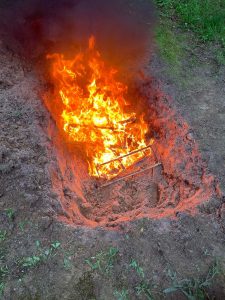
Figure 2: Burning the second hive with AFB was the right decision for Robert’s situation.
Photo courtesy of Robert Candido.




